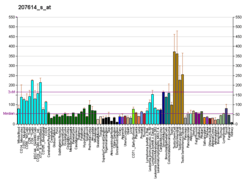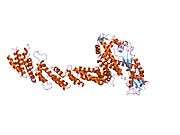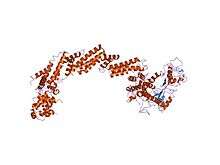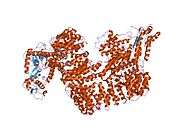CUL1
Cullin 1, also known as CUL1, is a human protein and gene from cullin family. This protein plays an important role in protein degradation and protein ubiquitination.
This is an essential component of the SCF (SKP1-CUL1-F-box protein) E3 ubiquitin ligase complex, which mediates the ubiquitination of proteins involved in cell cycle progression, signal transduction and transcription. In the SCF complex, it serves as a rigid scaffold that organizes the SKP1-F-box protein and RBX1 subunits. May contribute to catalysis through positioning of the substrate and the ubiquitin-conjugating enzyme.
This protein is a part of a SCF complex consisting of CUL1, RBX1, SKP1 and SKP2. It also interacts with RNF7. Part of a complex with TIP120A/CAND1 and RBX1. The unneddylated form interacts with TIP120A/CAND1 and the interaction negatively regulates the association with SKP1 in the SCF complex. Interacts with COPS2.
It is expressed in lung fibroblasts.
The protein is neddylated, which enhances the ubiquitination activity of SCF. Deneddylated via its interaction with the COP9 signalosome (CSN) complex.
Further reading
- Kipreos ET, Lander LE, Wing JP, et al. (1996). "cul-1 is required for cell cycle exit in C. elegans and identifies a novel gene family". Cell. 85 (6): 829–39. doi:10.1016/S0092-8674(00)81267-2. PMID 8681378.
- Bonaldo MF, Lennon G, Soares MB (1997). "Normalization and subtraction: two approaches to facilitate gene discovery". Genome Res. 6 (9): 791–806. doi:10.1101/gr.6.9.791. PMID 8889548.
- Lisztwan J, Marti A, Sutterlüty H, et al. (1998). "Association of human CUL-1 and ubiquitin-conjugating enzyme CDC34 with the F-box protein p45(SKP2): evidence for evolutionary conservation in the subunit composition of the CDC34-SCF pathway". EMBO J. 17 (2): 368–83. doi:10.1093/emboj/17.2.368. PMC 1170388. PMID 9430629.
- Michel JJ, Xiong Y (1998). "Human CUL-1, but not other cullin family members, selectively interacts with SKP1 to form a complex with SKP2 and cyclin A.". Cell Growth Differ. 9 (6): 435–49. PMID 9663463.
- Ng RW, Arooz T, Yam CH, et al. (1998). "Characterization of the cullin and F-box protein partner Skp1". FEBS Lett. 438 (3): 183–9. doi:10.1016/S0014-5793(98)01299-X. PMID 9827542.
- Winston JT, Strack P, Beer-Romero P, et al. (1999). "The SCFbeta-TRCP-ubiquitin ligase complex associates specifically with phosphorylated destruction motifs in IkappaBalpha and beta-catenin and stimulates IkappaBalpha ubiquitination in vitro". Genes Dev. 13 (3): 270–83. doi:10.1101/gad.13.3.270. PMC 316433. PMID 9990852.
- Tan P, Fuchs SY, Chen A, et al. (1999). "Recruitment of a ROC1-CUL1 ubiquitin ligase by Skp1 and HOS to catalyze the ubiquitination of I kappa B alpha". Mol. Cell. 3 (4): 527–33. doi:10.1016/S1097-2765(00)80481-5. PMID 10230406.
- Ohta T, Michel JJ, Schottelius AJ, Xiong Y (1999). "ROC1, a homolog of APC11, represents a family of cullin partners with an associated ubiquitin ligase activity". Mol. Cell. 3 (4): 535–41. doi:10.1016/S1097-2765(00)80482-7. PMID 10230407.
- Marti A, Wirbelauer C, Scheffner M, Krek W (1999). "Interaction between ubiquitin-protein ligase SCFSKP2 and E2F-1 underlies the regulation of E2F-1 degradation". Nat. Cell Biol. 1 (1): 14–9. doi:10.1038/8984. PMID 10559858.
- Hori T, Osaka F, Chiba T, et al. (2000). "Covalent modification of all members of human cullin family proteins by NEDD8". Oncogene. 18 (48): 6829–34. doi:10.1038/sj.onc.1203093. PMID 10597293.
- Read MA, Brownell JE, Gladysheva TB, et al. (2000). "Nedd8 modification of cul-1 activates SCF(beta(TrCP))-dependent ubiquitination of IkappaBalpha". Mol. Cell. Biol. 20 (7): 2326–33. doi:10.1128/MCB.20.7.2326-2333.2000. PMC 85397. PMID 10713156.
- Morimoto M, Nishida T, Honda R, Yasuda H (2000). "Modification of cullin-1 by ubiquitin-like protein Nedd8 enhances the activity of SCF(skp2) toward p27(kip1)". Biochem. Biophys. Res. Commun. 270 (3): 1093–6. doi:10.1006/bbrc.2000.2576. PMID 10772955.
- Swaroop M, Wang Y, Miller P, et al. (2000). "Yeast homolog of human SAG/ROC2/Rbx2/Hrt2 is essential for cell growth, but not for germination: chip profiling implicates its role in cell cycle regulation". Oncogene. 19 (24): 2855–66. doi:10.1038/sj.onc.1203635. PMID 10851089.
- Furukawa M, Zhang Y, McCarville J, et al. (2000). "The CUL1 C-terminal sequence and ROC1 are required for efficient nuclear accumulation, NEDD8 modification, and ubiquitin ligase activity of CUL1". Mol. Cell. Biol. 20 (21): 8185–97. doi:10.1128/MCB.20.21.8185-8197.2000. PMC 86428. PMID 11027288.
- Hartley JL, Temple GF, Brasch MA (2001). "DNA cloning using in vitro site-specific recombination". Genome Res. 10 (11): 1788–95. doi:10.1101/gr.143000. PMC 310948. PMID 11076863.
- Wiemann S, Weil B, Wellenreuther R, et al. (2001). "Toward a catalog of human genes and proteins: sequencing and analysis of 500 novel complete protein coding human cDNAs". Genome Res. 11 (3): 422–35. doi:10.1101/gr.GR1547R. PMC 311072. PMID 11230166.
- Lyapina S, Cope G, Shevchenko A, et al. (2001). "Promotion of NEDD-CUL1 conjugate cleavage by COP9 signalosome". Science. 292 (5520): 1382–5. doi:10.1126/science.1059780. PMID 11337588.
- Fukuchi M, Imamura T, Chiba T, et al. (2001). "Ligand-dependent degradation of Smad3 by a ubiquitin ligase complex of ROC1 and associated proteins". Mol. Biol. Cell. 12 (5): 1431–43. doi:10.1091/mbc.12.5.1431. PMC 34595. PMID 11359933.
- Senadheera D, Haataja L, Groffen J, Heisterkamp N (2001). "The small GTPase Rac interacts with ubiquitination complex proteins Cullin-1 and CDC23". Int. J. Mol. Med. 8 (2): 127–33. doi:10.3892/ijmm.8.2.127. PMID 11445862.
- Kiernan RE, Emiliani S, Nakayama K, et al. (2001). "Interaction between cyclin T1 and SCF(SKP2) targets CDK9 for ubiquitination and degradation by the proteasome". Mol. Cell. Biol. 21 (23): 7956–70. doi:10.1128/MCB.21.23.7956-7970.2001. PMC 99964. PMID 11689688.
External links
- Human CUL1 genome location and CUL1 gene details page in the UCSC Genome Browser.
- GRCh38: Ensembl release 89: ENSG00000055130 - Ensembl, May 2017
- GRCm38: Ensembl release 89: ENSMUSG00000029686 - Ensembl, May 2017
- "Human PubMed Reference:". National Center for Biotechnology Information, U.S. National Library of Medicine.
- "Mouse PubMed Reference:". National Center for Biotechnology Information, U.S. National Library of Medicine.








